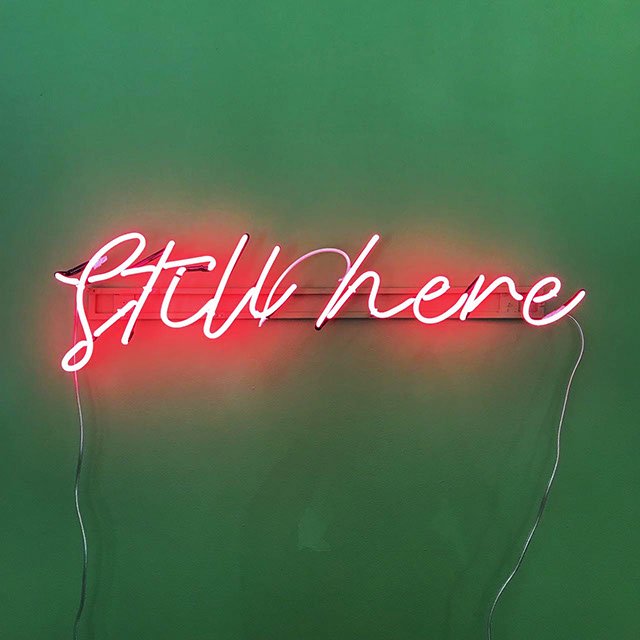Ronél de Jager -
Still Here
11.06.22 – 05.07.22
Solo Exhibition at
Kalashnikovv Gallery,
Johannesburg
Exhibition Statement
“She lay every morning under an avalanche of details, blissed pictures of breakfasts in Patagonia, a girl applying her foundation with a hard boiled egg, a shiba inu in Japan leaping from paw to paw to greet it’s owner, ghostly pale woman posting pictures of bruises – the world pressing closer and closer, the spiderweb of human connection grown so thick it was almost a shimmering and solid silk, and the day still not opening to her. What did it mean that she was allowed to see this?” - Patricia Lockwood, No One Is Talking About This
Still Here showcases Ronel de Jager’s latest body of work - paintings, prints and a beaded work made in collaboration with Qaqambile Bead Studio. De Jager contemplates the disintegrating boundaries between real and not real, and the consequent effects on our personal relationships and our relationships to ourselves. By integrating digital tools into her painting practice and remastering the Vanitas style from the 17th and 18th century Dutch masters, this body of work takes apart the pixelated life with a sensitivity that makes it poetic, even bearable.
Confined to our domestic spaces for two years and forced to communicate online, we were confronted with the issue of what it meant to actually talk to each other. The easiest way to share our lives and find out what is happening in the world is through social media. But as social media is a perfect site for curating the self and living in the bubble of your algorithm, more time is spent on creating these digital realities than living outside them. We have even surpassed a point where one can easily refuse to participate in social media as it weaves itself into every fibre of contemporary life. The choice seems to either post about yourself or to cease to exist. De Jager explores these notions, deploying the structure of the Vanitas ‘still life’ (used by artists to give objects symbolic meaning) to introduce us to the significance of the ceremonial bouquet.
Is there a difference between a real bouquet that is gifted and the bouquet emoji that is texted, if both are sent to console a loved one? Has difference between real flowers and digital flowers ceased to be relevant? When the boundaries between real and unreal are already so complex with objects as mundane as flowers, one can easily extrapolate a much deeper level of complication in the rest of our lives online. This sense of curation, of arranging the appearance of our digital lives and profiles is echoed by De Jager’s interest in the curated arrangement of flowers that makes up the bouquet. These flower arrangements, in their own temporality and propensity to decay within a short time, thus become symbolic of our connection to others as well as to our own minds.
Scrolling the web for thumbnail-sized images of bouquets, De Jager reworks vast amounts of images through a process of digital manipulation via numerous applications on her cellphone. This process allows her to distance the image from its original source on the web and break it down to basic elements such as form, colour and light. The strange distortion created by this process of choice/elimination is furthered by the process of enlargement from thumbnail to canvas. De Jager aims to capture the vivid colours we see glowing on our screens in the same manner that natural light influenced the Dutch old masters. Working within the constraints of a small studio space which limits her ability to see the canvas in its totality, she is forced to hyper fixate on details unfolding on the surface. When she does want to create distance between herself and the work, she makes use of the viewfinder on her phone, creating a picture within a picture and translating the real back into the digital. It is this constant play between the image and the canvas, the digital and the real that is mastered by De Jager in the time-consuming nature of translation and retranslation.
Existing both online and offline is a strange and bizarre life that requires bizarre ways of analysing and reflecting on. This is perhaps best expressed by the poet Patricia Lockwood as she writes about the poetic desensitisation created by a world accessed through a screen:
‘Someone was dead, she had never met him, yet she zoomed in on the texture of his injuries a dozen times, as she might squint at the pink of a sunset she was too lazy to meet outside. And that is what it was like.’ - Patricia Lockwood, No One Is Talking About This
We are Still Here, but what does it mean to be here? In the same way that De Jager’s works loses elements in shifting between digital and physical, Still Here asks, what do we lose when we are constantly translating ourselves between online and offline?
Text by Carina Jansen
'STAY', 2022, Oil on canvas with colour box frame, 1500 x 1000mm
'Creature of Comfort', 2022, Oil on canvas panels (triptych), 2000 x 3000mm
'OH THE DRAMA', 2022, Oil on canvas, 2000 x 1500mm
'Feed the Fuckery/Felt Cute', 2022, Oil on canvas, 1200 x 1200mm
'Things I Never Told You', 2022, Oil on canvas, 1800 x 1500mm
Exhibition Installation
'All That Glitters... is Glass', 2022, Glass beads on board with black box frame, 1000 x 1000mm
'Still Here' 2022, Fluorescent neon light, 1090 x 270mm
Exhibition Installation
'What does not break will bend', 2022, Ten-colour, hand pulled, silkscreen print on archival cotton paper, signed and numbered by the artist, and chopped with a Floodhouse signature stamp, 700 x 430mm









